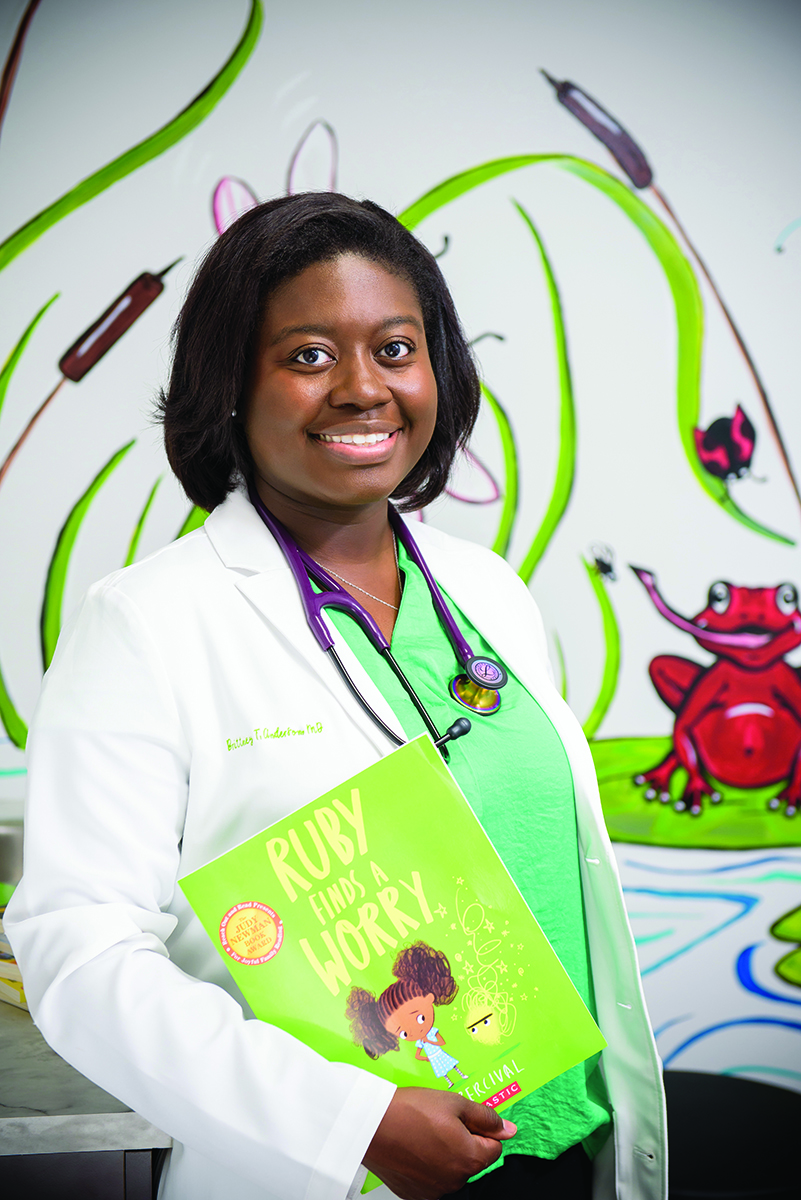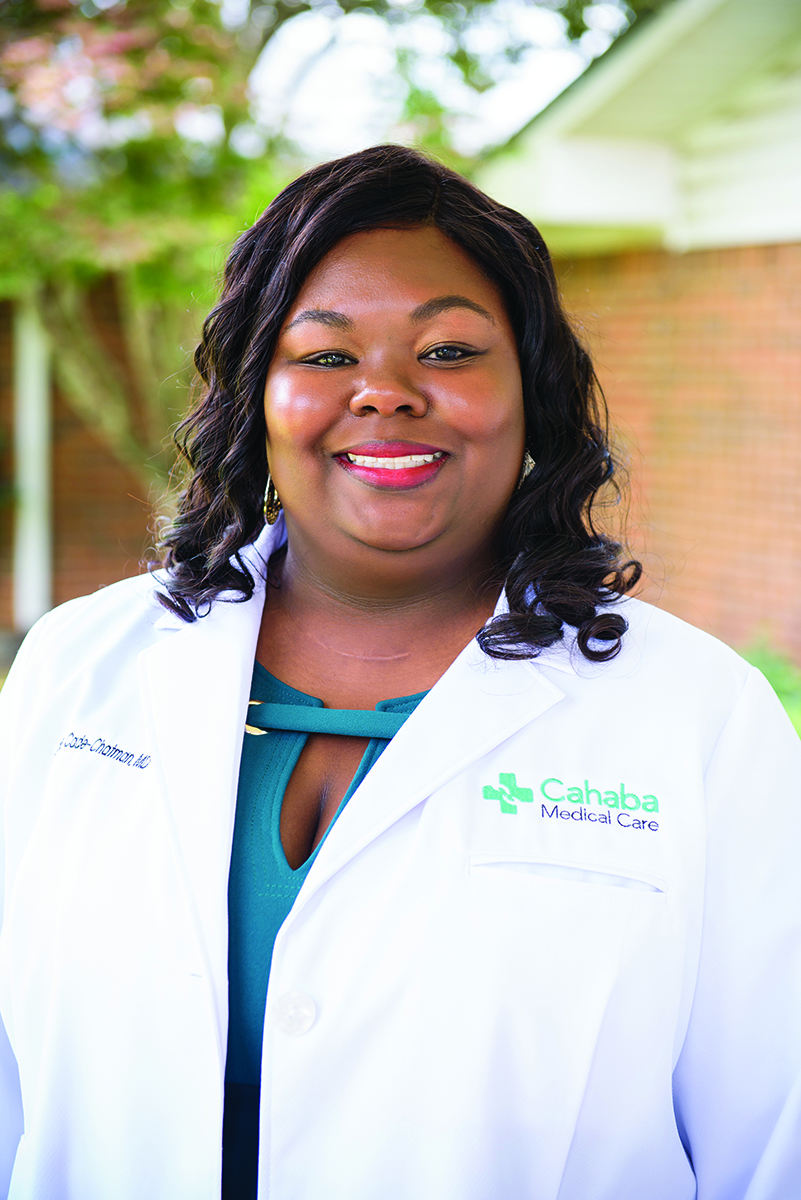The quote “You can’t be what you can’t see” by civil rights activist Marian Wright Edelman is one UAB Heersink School of Medicine 2014 alumna Brittney Anderson, M.D., often cites as her motivation to help mentor and recruit more Black students into the medical profession. The lack of role models and exposure to how one pursues a career in health care is an important factor in Black underrepresentation in medicine.
At age 6, Anderson made it her goal to serve others by becoming a physician. She says her ability to believe she could become something she’d never seen—a Black female physician—was due largely to her love of reading. Books transported Anderson, who grew up on a small family farm in Autauga County, to faraway places and opened her mind to other ways of life.
“Reading exposed me to what was outside of our dirt-road farm,” Anderson says. “It showed me there were people who lived differently and interesting things going on outside our farm in Alabama. Reading was the vehicle that helped me realize the possibilities that were out there.”
A sense of boldness and being open to opportunities runs in Anderson’s family. The farm she grew up on was land her great-grandfather bought after decades of his family working and sharecropping the land. At the time, he was among the few Black landowners in the area.
“It was a great place to grow up. The main crop was sugar cane, and we had a syrup mill. After working several years at Prattville’s cotton gin, he farmed crops to sell. But he gave away more than he sold. He always did his part to ensure those in our community could feed their families.”
 "Reading exposed me to what was outside of our dirt-road farm. It showed me there were people who lived differently and interesting things going on outside our farm in Alabama.” – Brittney Anderson
"Reading exposed me to what was outside of our dirt-road farm. It showed me there were people who lived differently and interesting things going on outside our farm in Alabama.” – Brittney Anderson
As much as she loved the farm, when it came time to begin her journey toward her life’s goal, she eagerly ventured out—first to Duke University in North Carolina, where she threw herself into her undergraduate studies and enjoyed the freedom of living away from home for the first time. Then, after her junior year, she completed a study abroad trip to Ghana, West Africa, which proved transformative.
Stricken with malaria, Anderson had an up-close-and-personal experience of the country’s health care system. She was struck by how poor access to physicians and resources resulted in long travel distances and negative effects on health.
Inspiration struck: She knew where she was needed. “I was so excited,” she says. “When I got back, I told my parents, ‘They need me there. That’s where I’m going to practice when I finish my training.’”
Her father had a different viewpoint. Look around, he told her, there are problems here at home. People need you here, he said. A check around her home county proved her father right, and it wasn’t just in Autauga that people struggled to access health care. Since 2005, seven rural Alabama hospitals have closed and 30 more are at risk. A shortage of rural physicians means patients must travel long distances for care.
Her interest piqued, she got accepted into the Rural Medical Scholars Program, a partnership between the Heersink School of Medicine and the school’s Tuscaloosa Regional Campus, housed at the University of Alabama’s College of Community Health Sciences. There she learned about the health care disparities in rural areas across the state that result in higher rates of disease, increased mortality, and lower life expectancies.
More importantly, she learned she could make a difference without leaving her home and family behind. In July 2022, Anderson opened Anderson Family Care in Demopolis, and says she has already experienced the best of what rural practice has to offer.
“It’s been overwhelming, but in a great way,” she says. “The support we’ve had from the town and its leaders has been great. We’ve been seeing a full schedule of patients and we’ve had so many people stop in just to say ‘hey’ and ‘we wish you well.’ Some have even brought us lunch. Our motto for the clinic is ‘We treat your family like family,’ and that’s what it feels like—we’re just family.”
Another way Anderson is working to alleviate the access problem by helping recruit more underrepresented minorities into health care professions. She has worked with the Heersink School of Medicine/Medical Alumni Association Underrepresented in Medicine (URiM) Initiative, which seeks to increase and enrich Alabama’s physician workforce by recruiting more diverse students. She speaks with high school students, and at her church she started the Bright Futures Health Interest Group, a monthly Zoom meeting that features Black health professionals talking with students about their specialty, from therapists to technicians to physicians. To top it all off, Anderson also writes a regular blog called Melanin Mentor, M.D., in which she speaks to Black pre-med students as a big sister or mentor would to help them through their training.
“Everything I do as a physician, from encouraging the next generation of health care workers to treating patients in clinic, gets to the heart of who I am and to the legacy of my parents and grandparents,” Anderson says. “I just want to help people; and to do so in the most genuine and compassionate way I can.”
 "Cahaba has opened my eyes to what could be in all rural areas. You shouldn’t have to have less than just because you’re rural.” – Arnelya Cade Chatman
"Cahaba has opened my eyes to what could be in all rural areas. You shouldn’t have to have less than just because you’re rural.” – Arnelya Cade Chatman
A Journey Worth Taking
By age four, Heersink School of Medicine 2015 alumna Arnelya Cade Chatman, M.D., was proclaiming her goal to become a pediatrician. High aspirations for a young Black girl growing up in the small town of Thomaston, Alabama (population 326), perhaps, but her exposure to the medical field had come early, when at age 2 she began a five-year ordeal of gastrointestinal symptoms that had her in and out of the hospital with no diagnosis. Finally, a doctor diagnosed the cause as anxiety.
“It was brought on by the death of my grandfather,” Chatman says. “He was my main caretaker and the loss was shattering. It was frustrating even back then being sick for so long and not getting a diagnosis.”
The summer following seventh grade solidified her determination to become a physician. Her grandmother experienced a stroke that summer, and her care fell to Chatman. She quickly learned how to cook, ensured her grandmother took her medications, and did all she could to nurse her back to health. It was her first health care success.
“Oh, she’s still with us,” Chatman laughs easily. “She’s still going strong at 97.”
Growing up in a small town, Chatman became aware of disparities in rural health care early on. The nearest physician was 26 miles away in Demopolis, which was a problem for those without transportation or money for gas. Lack of health insurance, hospital closures, elevated drug costs, an older and sicker population, and high poverty levels were, and still are, challenges for rural health in Alabama.
Chatman learned more about these disparities her junior and senior years of high school when she participated in the University of Alabama Rural Health Scholars (RHS) program and the Minority Rural Health Pipeline Program (MRHPP), where she lived on campus and took college courses, attended tutorials and seminars, and shadowed health care professionals, and took field trips to rural medical facilities.
“I was fortunate to be able to do those programs,” Chatman says. “I earned college credit, we learned about various health care professions, we met doctors, nurses, and pharmacists, and took tours of rural hospitals. Plus, I took chemistry and was able to use a lab for the first time. My high school was so small it didn’t have a working lab.”
Continuing in the Rural Scholars Programs after obtaining her chemical engineering degree at the University of Alabama, she was then accepted into the Rural Medical Scholars Program, where for the first time, the high school valedictorian and undergraduate magna cum laude student found herself struggling.
In addition to the sudden wave of new school work, the daytime sleepiness that had plagued her for years became overwhelming. She sought help and, again, spent years searching for a diagnosis.
“I just couldn’t stay awake to study. A 30-minute power nap would turn into two hours and I was really struggling.”
She somehow powered her way through her studies, earning her medical degree from Heersink School of Medicine. It wasn’t until her intern year of residency that she was diagnosed with narcolepsy and began taking medication. That (second) struggle for a diagnosis informs her patient care philosophy, she says.
“I don’t want my patients to go through that,” she says. “It’s important that they know I take them seriously and that I’m there for them.”
On Match Day, Chatman matched with Cahaba Medical Care in a new community-based family medicine residency program, a partnership with the Heersink School of Medicine’s Department of Family and Community Medicine. It was a natural fit. Cahaba Medical Care has locations in several Alabama counties, and is dedicated to helping both underserved urban and rural patients get the care they need.
Now practicing at the center’s office in Woodstock, Alabama, Chatman is happy for the resources they provide, including dieticians, social workers, counselors, prescription and financial assistance, and programs that help ensure patients with limited resources can get to specialist appointments.
“Cahaba has opened my eyes to what could be in all rural areas. You shouldn’t have to have less than just because you’re rural,” she says.
In addition to the care she provides at Cahaba, Chatman, like Anderson, is active in the SOM/MAA URiM initiative. She was featured in a promotional video for the initiative and continues to work with the Outreach Committee’s SPARK program to “spark” interest in the health professions in junior-high and high school minority students and provide mentorship. Her story, no doubt, is an inspiration and she is certainly a good role model for students who can see themselves in the woman who was once a little Black girl from tiny Thomaston, Alabama.
“It’s been quite the journey. If I had to do it all again, I would,” she says. “I really can’t see myself doing anything else. I’m fulfilled in what I do and I feel I’m making a difference. I really care about my patients and they care about me. It really is wonderful.”
Learn more about the URiM Initiative, and watch a video featuring Arnelya Cade Chatman at maa.uab.edu/urim. – Lynne Hall